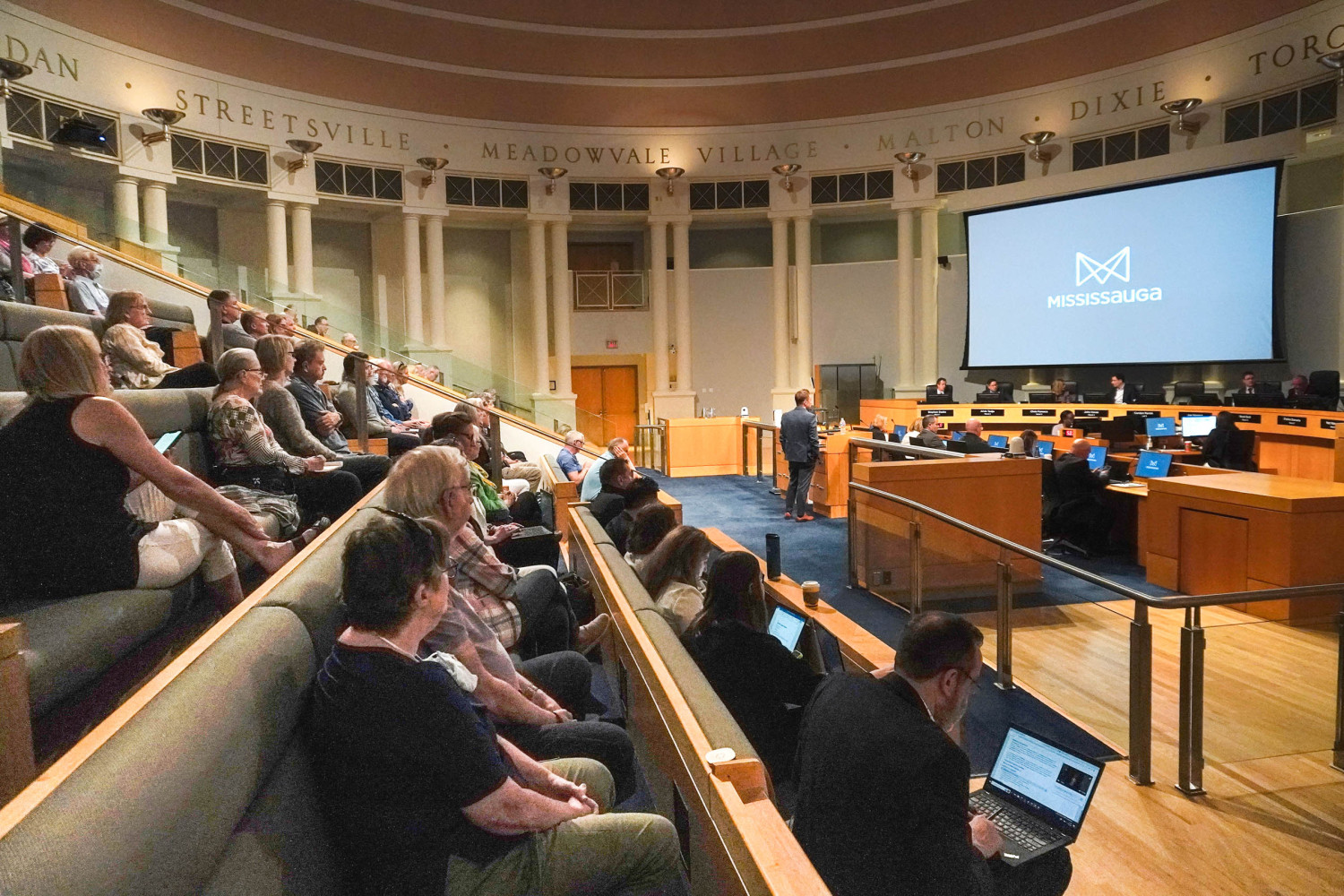
‘This is insanity’: PCs toss out 20 years of community planning for developer-driven chaos on Mississauga’s waterfront
For close to 20 years, the City of Mississauga and its residents have been planning one of the largest mixed-use developments in history along its eastern Lake Ontario shoreline.
The Lakeview development on the site of the former “Four Sisters” coal-fired power plant was the legacy of late councillor Jim Tovey who worked tirelessly to ensure residents of Mississauga remained connected to the natural beauty of Lake Ontario, even as the city grew taller.
Dozens of hours of consultation with residents and Indigenous groups, in public meetings, with staff, working on reports, studies and assessments were spent while millions of dollars helped reach an agreement between Lakeview Community Partners (LCP) and the City that included approximately 8,000 units and space for close to 17,000 new residents.
The historic development to reshape the entire eastern lakefront was designed with gradual density that protected the public’s access to Lake Ontario. A newly created conservation area to honour Tovey who passed away suddenly in 2018 after years of work on the unprecedented redevelopment of the former power station lands.
On Friday, the PC government and LCP snubbed their noses at all of it.
Ahead of the weekend, the PC government pulled the rug out from underneath the City and local residents by approving a Minister’s Zoning Order (MZO) request from Lakeview Community Partners that doubles the size of the previously-approved plan from approximately 8,000 units to 16,000. MZOs are supposed to be used for unusual circumstances, including emergencies, but the PCs under Doug Ford have instead used the tool to override municipal planning authority, effectively allowing developers to control crucial land use policy across the province.
The decision revealed Friday was made with zero feedback from City officials and residents, and puts the visionary plans that guided the planning for Lakeview up to this point through the shredder.
“The community has been working with Lakeview for over a decade to build a master-planned waterfront community that we can all be proud of, and this MZO pulls the rug from underneath them,” Mayor Bonnie Crombie said in statement to The Pointer. “We stand behind the countless hours of work and consultation we’ve done with the community. We have been reasonable and flexible where it makes sense, for example, approving their request to increase the density on the site from 6,800 units to 8,050 to respond to changing needs and market conditions.”
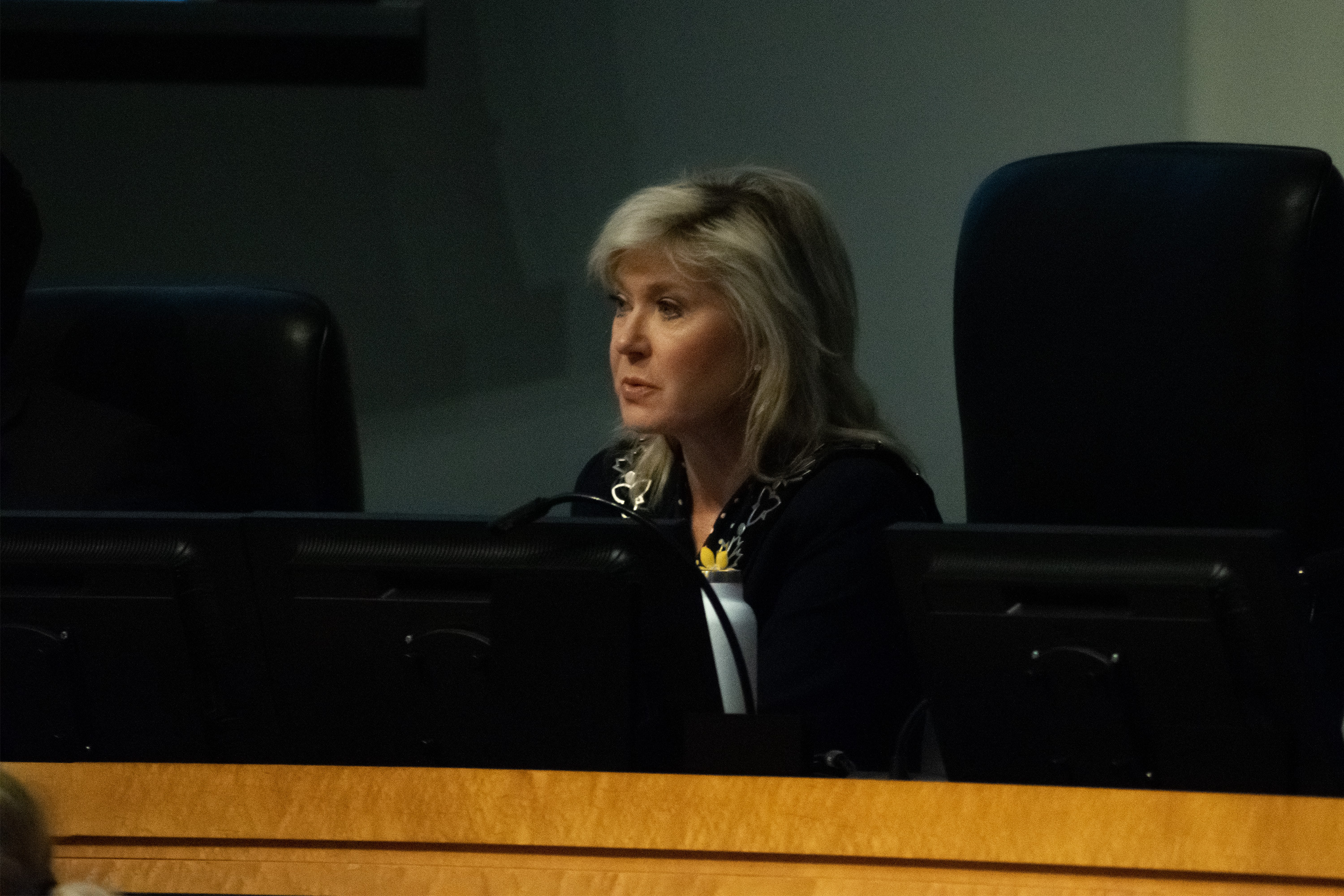
Mississauga Mayor Bonnie Crombie said she was "deeply disappointed" by the MZO approval.
(Alexis Wright/The Pointer files)
Councillor Stephen Dasko, whose ward includes the development now dubbed Lakeview Village and who previously worked closely with Tovey on plans for the area, said he was not made aware of the MZO approval until 5 p.m. on Friday. He says he was previously told a request had been made, but not the full scale of what LCP was requesting. He also admits he did not take the request seriously after nearly two decades of effort to reach the previously approved plan, seeing it as something more “aspirational” than anything serious.
He has been left stunned.
“It’s heartbreaking,” he said. “This totally cuts the legs out from everything that had been going on.”
According to a blistering report from Mississauga City staff, LCP has requested the removal of any height and density restrictions, save for buildings directly fronting the lake (to be limited to 10 storeys); the elimination of minimum setbacks for front or side yards (meaning more units can be crammed closer together); and the reduction in required sizes for apartment amenity areas, landscape features and parking areas for residential, commercial and employment uses. The MZO has also eliminated the requirement for townhomes.
This is despite significant concessions the City of Mississauga had already handed LCP to increase the density to what the developers envisioned for the project. Prior to the MZO request, LCP, a consortium of builders, engineering firms and developers, had already been given permission to build higher and denser than what existing zoning allowed in the area. Roads would be thinner than other areas of the city; and the footprint of a school property planned in the area was reduced by cutting yard space. These incentives were offered in addition to reduced building setbacks, reduced parking standards, reduced landscaped areas and amenity spaces for apartments and smaller setbacks from natural areas.
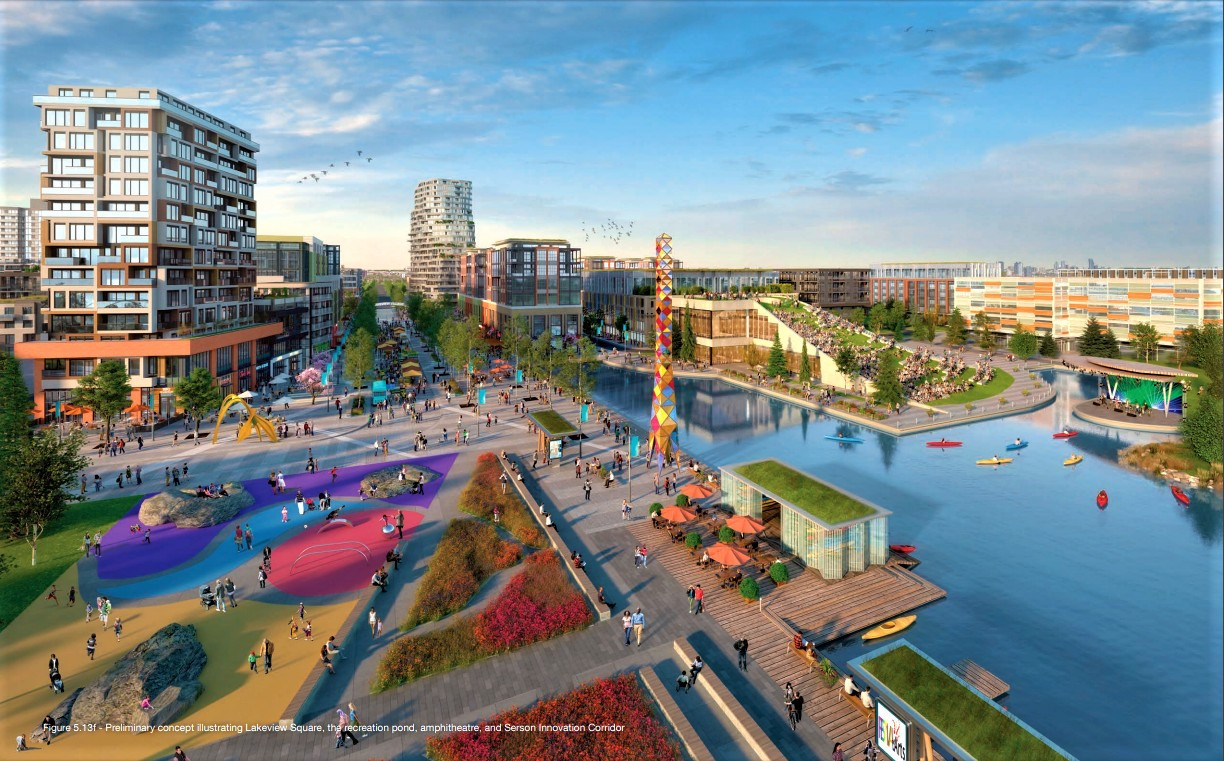
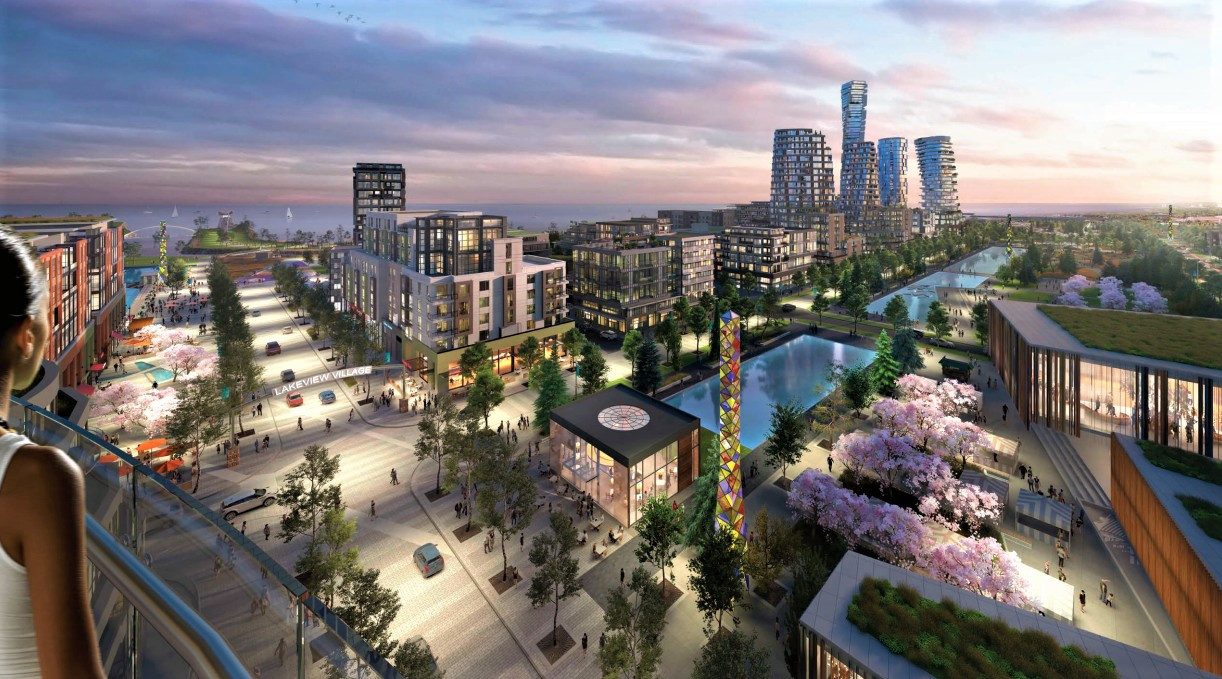
Previous renderings of the vision for Lakeview Village. These are effectively useless as the footprint of the development will radically change following the MZO approval.
(LCP)
Councillor Dasko says the MZO is incredibly poor decision making, and has left him questioning the motivation of Lakeview Community Partners to go behind the back of the City and undermine the entire process, including close to 20 years of work.
“This has been a collaborative process all the way through,” he says. “Honestly, I can’t say what the motivation has been.”
“It’s not wanted, not requested and quite frankly doesn’t fit.”
A request for comment sent to LCP was not returned.
Not only does the MZO approval completely eliminate the work and consultation from staff and community members, but according to City staff, in many ways it’s unmanageable growth planning to accommodate densities that simply cannot be supported by municipal and provincial infrastructure. It remains unclear how the PCs will pay for the additional schools required, provincial services, GO system expansion, or how the City of Mississauga and Region of Peel will come up with revenues for municipal roads, stormwater and wastewater lines, recreation and community centres, libraries, fire and police stations, paramedics, social services and public health supports for tens of thousands of new residents.
The PC government has not explained where it will get tens of billions of dollars for all the required infrastructure and services under its plan, pushed by the development industry, to build 1.5 million new homes by 2031.
The roads in the Lakeview area were unable to support the already approved 8,050 units in the previously approved application; there is insufficient capacity for schools to accommodate the children that would come with 16,000 new units; the unlimited height being requested would cause issues with the adjacent wastewater treatment plant (particularly for units above the 20th floor where odours are worse); there is insufficient infrastructure to service the 16,000 units; there are no guarantees that affordable housing will be included as part of the development, which sits along a major transit corridor in Mississauga—despite the provincial government’s assertions in a press release posted Friday; and the approval of this many new units in the area will require a complete reworking of the City’s capital plan, triggering an upheaval of the ongoing Transit Project Assessment Process (TPAP) for the Lakeshore BRT, something that will create a web of financial problems and timing delays for the City.
According to a press release from the provincial government, the approval of the MZO—including two others for properties at 3355 and 5645 Hurontario Street—are needed in order to tackle the housing crisis in Ontario.
“Our government is continuing to act decisively to tackle the housing supply crisis and ensure Ontario has a range of housing options to meet demand,” Steve Clark, Minister of Municipal Affairs and Housing states in the release. “By aligning new housing with our government’s historic investments in transit and transit-related infrastructure, we are supporting the development of complete communities that will deliver on our commitment to help more Ontarians find a home that meets their needs and budget.”
The press release does not explain how limiting the housing options within Lakeview—eliminating the requirement for townhomes needed by families who are often shut out of the condo market which caters to one-bedroom buyers—will support the creation of complete communities.
Mayor Crombie expressed serious concern with the additional MZOs lumped in with the Lakeview Village approval, as there are currently no active development proposals before the City for those two sites. The sites at 3355 and 5645 Hurontario Street are owned by The Kaneff Group.
“They are both located on Hurontario near the future Hazel McCallion LRT and could have supported more density as they are considered in a major transit station area (MTSA). We would have welcomed the opportunity to have these discussions and negotiations with the developer to reach common ground before an MZO was unilaterally issued by the province. This is a concerning trend I hope we don’t see continue as cities play an important role in planning complete communities,” Crombie said.
The approval of these additional units form part of the PC government’s promise to build 1.5 million new homes by 2031 under Bill 23. However, Mississauga staff say the City can achieve its housing allocations—120,000 units—without the Lakeview MZO.
“Currently the City is processing applications or reviewing plans which when built out would total over 90,000 new units. The estimated unit capacity based on existing Official Plan permissions and Master Plans amounts to 246,000 new units which exceeds both the Regional Official Plan and Bill 23 targets,” the staff report explains.
The timeline for the MZO’s approval has left many councillors and staff members shaking their heads. A Planning and Development Committee meeting, scheduled for Monday night, was triggered by a request for comment from staff at the Ministry of Municipal Affairs and Housing on the proposed increase to 16,000 units. According to Andrew Whittemore, the City’s Commissioner of Planning and Building, the City was not even informed that LCP was seeking an MZO, Ministry staff only asked for comment on the “concept” of increasing the density to 16,000 units.
“The Province did not say it was an MZO,” Whittemore told council.
Monday evening’s meeting was initially meant as an opportunity for council to review and approve staff’s comments on what a massive spike in density would mean. However, the Province’s surprise move on Friday to approve the MZO made the meeting on Monday mostly moot, as MZO’s are final decisions and unappealable by residents or municipalities.
“This Wild West is here,” one Mississauga resident said to council during Monday’s planning meeting.
Trevor Baker, the president of the Lakeview Ratepayers Association was visibly upset while delegating to the planning committee, sharing his dismay that nearly 20 years of community effort has been swept aside by the PC government.
“We are pissed off and we are scared,” he said. “Lakeview Village was to be the jewel in the crown that is Mississauga.”
Other residents shamed the PC government for completely tainting the legacy of late councillor Tovey.
“I do wonder what Jim Tovey would be thinking right now and that saddens my heart,” resident Deborah Gosse said.
Staff explained that the MZO’s approval completely undermines the public planning process, something made worse by the fact that Lakeview has been viewed as a “planning success story for a landmark waterfront community”.
“The approved community plan went through multiple years of visioning, planning analysis and community consultation. In addition to the general community and the Lakeview Community Advisory Panel, engagement was conducted with the Mississaugas of the Credit First Nation, Eagle Spirits of the Great Waters and the Greatness The Great Lakes Project,” the staff report explains. “Thoughtful consideration was given to varying types of height, built form and housing types. The location of towers was deliberate and based upon collectively agreed upon principles. Community feedback was particularly instrumental in shaping the interface between the waterfront and the building heights closest to it.”
The MZO scraps all of this, including a schedule that outlined how the development could proceed without overwhelming the road network; controlling growth in the area to avoid odour issues with the adjacent wastewater treatment facility; and limiting development in particular areas of Lakeview to limit noise disruptions with nearby developments entering construction in the years ahead.
“We can’t just plan an entire city on the back of a napkin, but that’s exactly what this government is doing,” Councillor Alvin Tedjo said. “It’s just completely irresponsible.”
“This is insanity,” Councillor Dipika Damerla added.
According to the staff report, the roads in the Lakeview area—previously used to service the limited traffic coming and going from the power plant—were incapable of supporting the previously approved 8,050 units. A phased approach was to be taken to ensure that as Lakeview Village grows, the roads and City transit system would be upgraded to accommodate the increased number of residents. No plans or studies have been completed to assess the impact of the residents that would arrive to fill 16,000 units. There are only two access points into Lakeview Village from Lakeshore Road East—via Lakefront Promenade and Hydro Road. Additional streets are planned, but due to these extensions running through private property, it’s unknown when these roadways could be built. It’s a recipe for a traffic congestion nightmare in the area.
The additional density and height would also create a health and safety issue with the adjacent G.E. Booth wastewater treatment facility. According to staff, the higher the unit, the smellier things potentially become.
“Information gathered through the review of the supporting studies for compatibility to the G.E. Booth waste water treatment facility revealed that emissions being released from the smoke stack can impact residential units above a certain height,” the report states. “The request for unlimited heights is concerning from a land use compatibility and health and safety perspective, particularly for some towers where storeys exceed the high twenties.”
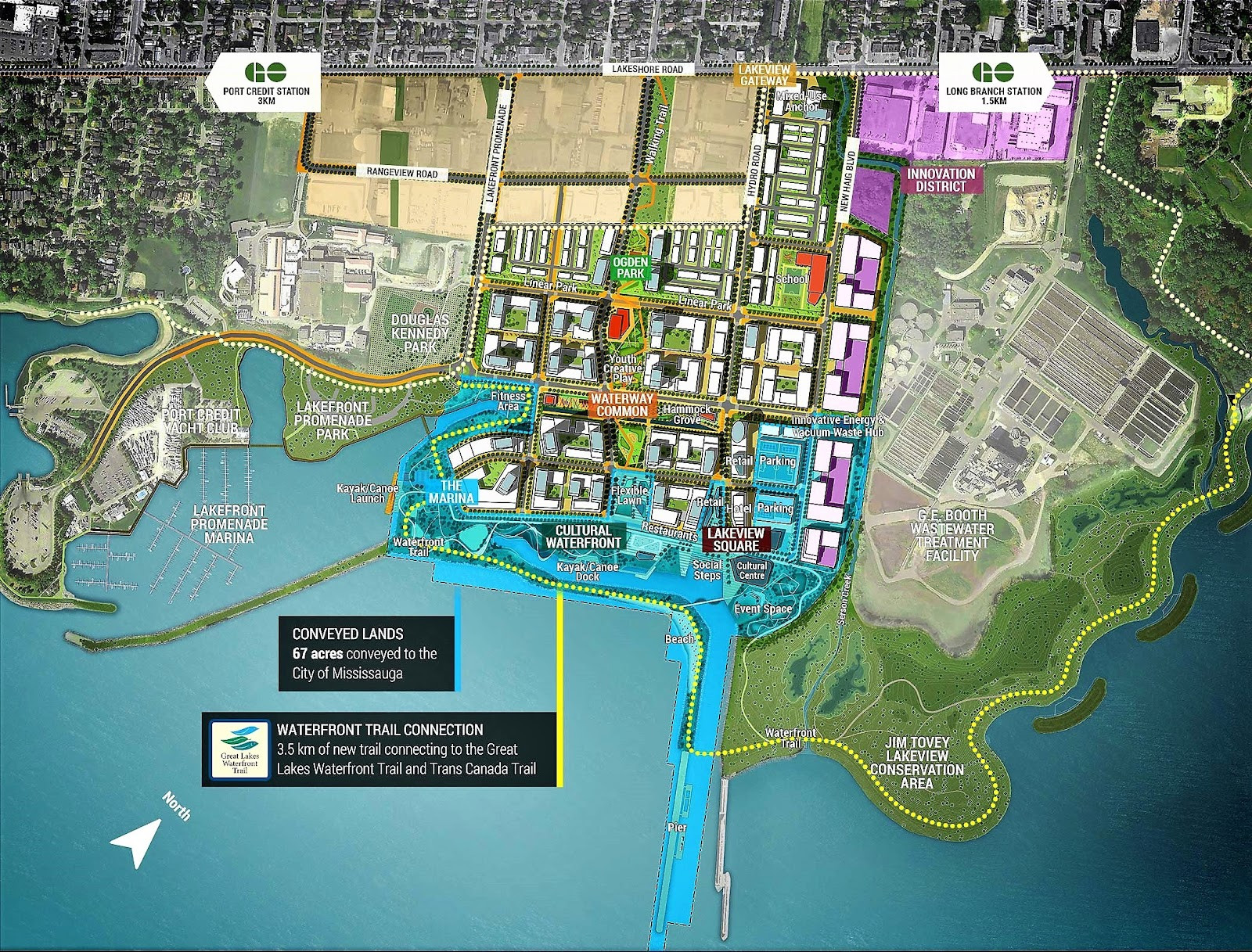
The adjacent wastewater treatment facility could create a health and safety issue if large apartment towers are constructed nearby on the Lakeview lands.
(City of Mississauga)
This is not the first time the nearby wastewater facility has created issues for the Lakeview development.
In December 2019, a disagreement arose between Lakeview Community Partners and the Region of Peel about who would pay to deal with the smell of sewage.
An assessment was conducted by the Region of Peel to consider the impact dust, noise and odour might have on the new housing development. Distance was found to mitigate noise, vibration and dust concerns “for the most part”, but the smells were not solved by the location. Instead, “unique measures” were required to keep residents protected from the sometimes unbearable odour.
The staff report at the time suggested carbon filters could be added to building ventilation systems, coverings could be applied to the treatment facility or even odour filtration systems.
But the real disagreement was around which entity would pay for such solutions.
The developers argued any mitigation measures should be funded through development fees. Despite the fact LCP’s planned development next to the sewage plant was 30 metres nearer than guidelines set by the Ministry of Environment, Conservation and Parks suggest it should be. It is also significantly closer than any current properties, all of which sit at least 400 metres from the treatment plant.
The Region said with Lakeview choosing to build so close to a treatment plant, the cost should fall to them. The end result saw LCP shouldering the costs—approximately $366,000.
Further issues created by the MZO approval include school capacity, with the single public school planned as part of Lakeview Village being unable to accommodate the number of students that would come with the doubling of the originally planned number of units.
“There is no additional public school capacity within the catchment area of the community,” the staff report states.
It means any families moving into the area may be forced to transport their children for schooling elsewhere in the city. The additional residents also raises the potential need for a new high school, for which there is no space currently planned.
“One strike of a pen eliminated a waterfront that was going to be the envy of the world,” Councillor Dasko said Monday evening.
Moving forward, the Province says a “Land Facilitator” will be appointed to work with Mississauga to ensure the infrastructure in the area can be upgraded to handle the increased density. But Mayor Crombie says there are significant issues with focusing so much development along transit corridors, and providing free rein for developers to squeeze in as many units as they desire.
“We want to build complete communities, places where you want to live, where you want to work, where you want to raise your children,” the Mayor said Monday evening. “We don’t want to have to do it by building mega towers along transit corridors with single bedrooms.
“We are here tonight, equally as frustrated as you.”
Email: [email protected]
Twitter: @JoeljWittnebel
At a time when vital public information is needed by everyone, The Pointer has taken down our paywall on all stories relating to the pandemic and those of public interest to ensure every resident of Brampton and Mississauga has access to the facts. For those who are able, we encourage you to consider a subscription. This will help us report on important public interest issues the community needs to know about now more than ever. You can register for a 30-day free trial HERE. Thereafter, The Pointer will charge $10 a month and you can cancel any time right on the website. Thank you
Submit a correction about this story


